BICYCLING IN CHINA
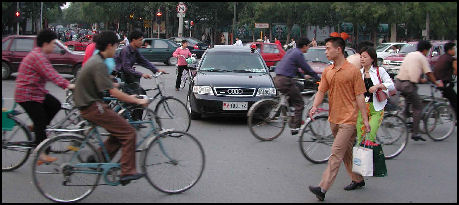
Bicycling in Beijing
Bicycling is a great way to see China. There are many beautiful roads in the mountains and through the countryside. The best thing to do is get a good map, pick some country roads and stay off the main roads. Before you do a long tour check the wind direction so you are not heading into a head wind and/or can enjoy a tailwind.
Most airlines allow you take your bike for free on international flights if it is one of your two check-in items. If you bring a bike with you on a plane you have to take off the wheels, pedals, and handlebars and place the bike in a box. In some countries you can carry them for free on domestic flights but sometimes there is a fee.
It usually possible to take your bicycle on buses in China. Trains are sometimes a problem. In some cases either they don't take bicycles are your bicycles will arrive several a few days after you. For information about tours check the bicycling magazines.
There are something like half a billion bicycles in China, more than any other country. There are seven million registered bicycle riders in Beijing and 6.5 million in Shanghai. In many places bicycles still outnumber cars at least 10 to 1.
In the Mao era bicycles were regarded as one of "three bigs" — along with a sewing machine and wristwatch. People placed their names on waiting lists for years to get them and took out loans form the factories where they worked to help pay for them. Chinese valued bikes in part because the public bus system was so bad and owning a car was impossible.
China has roads and reserved for bicycles. Roadside bicycle repairmen are common sights. The Chinese ride their bicycles in the rain and snow. Up until fairly recently when it rained in Shanghai, the streets filled with bicycle riders in blue, yellow, red and purple ponchos. There were so many bicycles in Shanghai that sometimes traffic stammered to a halt with bicycle gridlock.
These days, bicycle use is declining in many places as more and more have access to cars. In 1998, bicycles were banned from East Xisi Street, near the Forbidden City in Beijing, to make it easier for car traffic. Violators where chased down guards with bullhorns and red arm bands. The ban was extend to other streets later on. Bicycles were banned from all major roads in Shanghai in 2004 to make more room for cars.
Bicycle Riding Areas include the Guilin area, the Dali and Lijiang areas of Yunnan Province, Beijing or anywhere there is some nice countryside. There are also zillions of dirt roads ideal for mountain biking.
Renting a bicycle and cruising around like an ordinary Chinese is the highlight of many people’s trip to Beijing. Some hostels and hotels rent bikes. Those that don’t usually know where you can rent one. Before you set out make sure the tires have enough air and the brakes work. Get a lock and make sure you know how to use it. If you have a problem there are plenty of curbside bicycle repairmen to help you out.
As a rule stick to the bike lanes and blend in with the crowd and go with the flow. Most Chinese ride at a pretty slow pace. Stay on the main bike lanes and be aware of what is going on around you. Avoid busy side roads that have a lot of bus and taxi traffic. Don’t try to take shortcuts. You can end up getting hopelessly lost.

Winter swimmer in Harbin
”Beijing bicyclists pedal differently from their Western counterparts,” Joost Polak wrote in the Washington Post. “They set their seats a bit low, lean almost backwards and pedal with the arch or even the heels rather that ball of their feet, which plays their knees out on the upstroke.”
Explaining how his Chinese friend shifting across six lanes of traffic in Beijing Joost Polak wrote in the Washington Post, “Xian fang ,moved ahead to the first lane of cross traffic...Seeing a gap, she pushed through to the next lane, braked to a near standstill, them pumped her way across another ;ane. After a coupe more lanes I began to see the gaps that seemed so clear to her. And them it was time to look in the other direction and work our way across the traffic coming from our left.”
On the bike lanes Polak wrote,: “They are almost always wide enough for cars to fit into. So they do, Sometimes they nip into the bike lane because all of the vehicle lanes are slowing. Sometimes the drivers pull over ad park to make a cell phone call...Ad the bikes, electric and gas-powered motorbikes, delivery tricycles and pedicabs travel in both directions on each side of the street.”
Bicycles are an option in to handle yourself in traffic. Keep in mind though that each year there are around 350 bicycle related fatalities in Shanghai. Moreover, bicycles were banned from all major roads in Shanghai in 2004 to make more room for cars. In the Yangshuo area around Guilin bicycles (the typical Chinese ones are often stronger than the mountain bikes) can be rented for around $2 a day at several places. Many hotels in Kashgar rent bicycles for 35 cents an hour Web Sites: Bicycle Adventures Bicycle Adeventures Bike China Travelogues Bike China Travelogues Web Comments on Bicycling in China: Good Report Westport.k12 ; New York Times New York Times ;
Birdwatching
Birdwatching is pursued in the rain forests of Yunnan, the coastal areas around Shanghai and highlands of Tibet. Yancheng Reserve in the Yangtze Delta is home to red-crowned cranes, reed parrotbills. Oriental storks and the world’s last 2,000 or so black-faced spoonbills. The “wetland parks” in Yangtze Delta set up in a former area of reeds and swamps of the Yangtze Delta and largely devoid of bird life. Wolong Reserve in Sichuan is most famous for its pandas but is also home to 280 species of bird.
Dongting Lake (between Hunan and Hubei province) is a 2,820-square-kilometer lake which lies on the Yangtze River that provides wetlands for migrating birds. On Shahu Lake, 50 kilometers from Yinchuan in Ningxia, migrating birds congregate on a small island near the shore of the lake. Bird Island, on northwest part of Koko Nor, a lake in Qinghai Province, over 100,000 birds of different species can be found here at certain times of the year pecking through the muck looking for worms and things. It is now an island in name only because the water has dried up around it. This has put crimps on the birdwatching activities and tourism.
Birdwatching is bot that big in China. Birdwatchers are often mistaken for surveyors. They are often told there are no birds here or asked how expensive the bird is they are look ing for. A well-known birder in Shanghai old The New Yorker, “Whatever species you can find in the forest you can go to local market ans see in a cage.”
In a typical Chinese bird market toy can recently caught thrushes, skylarks and grosbeak, looking ragged in he cruelly-small cages. Sometimes sparrows are kept on leashes by children who tame them by quietly stroke their head. Budgies and minias are often raised in captivity. Exotic birds like fllvettas, leaf birds and yhina and caught in the south and transported o the north.
Songbirds are a passion among some Chinese. In one area of Temple of Heaven Park old men gather on Saturday or Sunday mornings with their songbirds in exquisite cages. Yichuan Park in Shanghai is where people bring their pet songbirds and hang them in cages from trees. Xinyuan Market is the largest bird and animal market in Guangzhou.. Web Sites:China Birding Hotspots China Birding Hotspots China Bird.net China Bird.net ; Birdwatching Tour,China Tibet Travel: China Tibet Travel ;Fat Birder Fat Birder . There are lots of good sites if you google “Birdwatching in China.”
Canal and River Trips
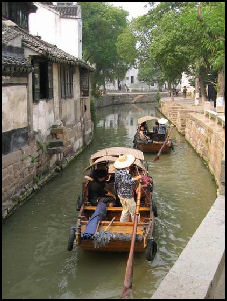
Canal trip near Shanghai
in Tong Li
Canal trips are offered south of the Yangtze on the Grand Canal but many tourist complain that the boats and the canal are filthy. Some sections are still quite busy. In the town of Suzhou, for example, snake-like processions of barges, a half mile long wait their turn to pass through a lock. In other places the pea-soup-colored water is filled with small boats carrying cement, sand, rolls of steel wire.
Canal trips are offered in Hangzhou and Suzhou: In between Hangzhou and Suzhou there are about 200 small towns connected by a web of canals. The main products have traditionally been silk and grain that were moved around on the water. In towns such as Wuzen many people still live in traditional houses that face the water and are connected by small stone bridges that cross the canals and streets paved with stone slabs. People get around in car-size, bamboo-roofed boats powered by a single oar connected to a stick. Web Sites: Google “Canal Trips in China” and many travel companies come up.
Cormorant Fishing
Cormorant fishing is done for tourists on the Lijiang River around Guilin and Yangshuo and on Lake Erhai in Dali in Yunnan Province. Cormorants are waterbirds, whose name means "crows of the sea." A member of the pelican family, they can fly at speeds of 50mph and are particularly adept at swimming underwater, which is why they are such skilled fish catchers.
Unlike most water birds, which have water resistant feathers, cormorants have feathers that are designed to get throughly wet Their feathers don't trap air like water resistant varieties. This make it easier for them to dive and stay submerged while they chase fish. But this also means that their feathers become waterlogged. Cormorants can dive as deep as 80 feet and stay underwater for more than a minute. When pursuing fish underwater they have their eyes open, their wings pressed against their bodies, kicking furiously with their legs and feet at the back end of their bodies.
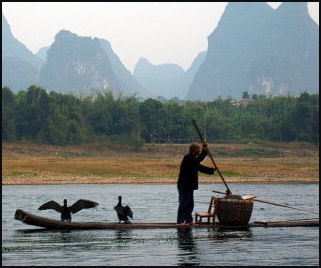
Cormorant fishing in the Guilin area Fishing cormorants go through a routine of diving, catching fish, surfacing and having the fish taken out of their mouth by the fishermen. A piece of string or twine, a metal ring, a grass string, or a hemp or leather collar is placed around their necks to prevent them from swallowing their fish. The birds often have their wings clipped so they don’t fly away and have a looped strings attached to legs that allow them to be retrieved with a pole by the fisherman.
Describing cormorant fishing by a man named Huang in the Guilin area, an AP reporter wrote in 2001: at the front of a bamboo raft, "his four cackling cormorants huddle together, preening feathers with long beaks or stretching wings. When he finds a promising spot Hun sets a net around the raft, about 30 feet out to hem fish in...Hung jumps and down a few times on the raft to break the bird's reverie. They snap to attention and jump into the water."
"Huang barks a command and the birds dive like arrows; they paddle furiously underwater chasing fish. Occasionally, fish jump up from the water, sometimes right over the raft, in their effort to escape....A minute or two elapses before cormorants's pointy heads and sleek necks bob up above the water. Some clutch fish. Some catch nothing. Hung plucks them from the water and onto his raft with his boat pole." (See Cormorant Fishing, Birds, Animals, Nature) Web Sites: Google “Cormorant Fishing China” and many sites come up.
Golf
Chinese claim they invented golf about 800 years ago, 400 years before the sport is said to have officially been invented in Scotland. In the Mao era the sport was associated with capitalists and running dogs. It was banned during the Cultural Revolution and allowed to return in 1985. China hosted its first major tournament in 1995 in Shenzen. As of 2006 there were around 240 golf courses in China with another 250 expect to open in the coming years.
By some estimates about 1 million Chinese play golf. Some people feel that China will experience a golf boom in the near future as Chinese become more affluent in the same way the Japanese did in the 1970s. The golf industry is growing at a rate of 20 percent a year. Golf shops and driving ranges are opening up all the time. Counterfeit Calloway clubs are widely available on thre streets of Beijing and Shanghai.
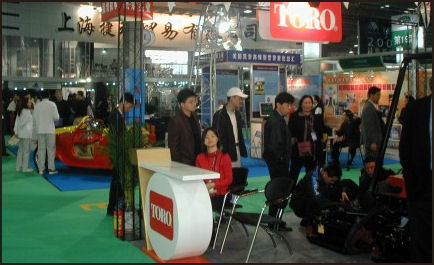
Golf show in China
The golf course is increasingly becoming a place to conduct business. One Chinese golf course developer told the New York Times, "In the past you built guanxi [connections] by wining and dining people in karaoke bars. But the Chinese are becoming more health conscious. Now you're invited to sweat with them on the golf course."
Rich businessmen like to make high-stake bets on the golf course. There are stories of a BMW or a Mercedes being wagered on a single hole and plots of land being bet on a single rounds of golf. One golf manger told the New York Times, "I know a group of players who bet for ships. They use two caddies: one to carry the clubs and the other to watch the other players to make sure they don't try to nudge the golf balls with their feet."
China had only 10 golf courses in 1994. By 2004, it had around 180 (compared to 30,000 in the United States) and roughly a thousand were under construction or being planned. About a third of them are in Guangdong Province, particularly around Shenzhen, where they cater to Hong Kong businessmen and an increasing number of nouveau rich mainland entrepreneurs.
Golf courses around Shenzhen have names like Shenzhen Tycoon and Noble Merchant. A membership in Taiwan-financed Tomson Golf Course in Shanghai — which reportedly has bunkers filled with powdered marble — cost $94,000. Visitors can play for $200 and have their clubs carted around by women caddies.
At the top of the gold course heap in China is the Mission Hills Golf Club, China's only international-standard golf resort and the largest golf complex in the world. It boasts ten courses. The nearest competitor, Pinehurst in North Carolina, has eight.
Opened in 1992 near Shenzhen, Mission Hills covers 2,300 acres and boasts a 500-room hotel, and a country club with 51 tennis courts, fairway-side mansions, a clubhouse with an 800-square meter palace with a cascading waterfall, and Asia’s largest golf shop. Membership fees are between $21,000 and $70,000. About half the members are from Hong Kong. The other half from the mainland.
There are golf courses in and around Beijing, Tiangjin, Shanghai, Guangzhou, Zhuhai and other places as well as Shenzhen. Some of have been designed by Arnold Palmer and Robert Trent Jones. Major golf clubs usually open their greens to foreign guests and green fees are moderate. Remember to bring your handicap certificate and a copy of your U.S. club membership.
Some golf course in China offer night golf for people who don’t want to damage their skin in the sun. A new golf course at Jade Dragon Snow Mountain near Lijiang in Sichuan Province claims to be one of the world’s longest. The thin air makes it possible to build par five holes that are nearly a half a mile long. Web Sites: Golf Today Golf Today
Hash House Harriers
Hash House Harriers are a social club popular with ex-patriots overseas. Once every few weekends the Harriers sponsor an event that is half running race and half scavenger hunt. Some participants take the race seriously, but most drink a few cold ones and have a good time. The Hash Harriers sponsor events in several locations in China. For information about local Hash Harrier groups try contacting the American, British or Australian Embassies.
Hash Harriers have been described as a "drinking club with a running problem." It was launched in Kuala Lumpur and nw can be found all over the world. When all else fails information on them can be obtained from the British embassy or consulate in the place where you are. Web Sites: Hash House Harriers Home Page Hash House Harriers ;China Hash House Harriers China Hash House Harriers
Hunting and Shooting Trips
Hunting and Shooting Trips are organized by travel agencies authorized by the government. These agencies take care of permits and provide information on seasons, weapons and ammunition. For more information contact the China National Tourism Office. Also check out ads in hunting magazines. The 35,000-member Safari Club International is the world largest big game hunting organization. Web Sites: Hunting Reports Hunting Reports
Jewish Travel: Tourist sights associated with Judaism can be seen in Harbin and Shanghai. See Places. Web Sites: Google it
Mountain Biking: see Bicycling.Mountaineering: see Hiking, Mountaineering and National Parks. National Parks: see Hiking, Mountaineering and National Parks. Nordic Skiing: See skiing.
Parks in Cities

Park fishing
Parks in the cities are a good palce to observe daily life and see how Chinese amuse themselves outdoors and stay fit, especially early in the morning or on Saturday or Sunday morning. Typically in one area old men gather with their songbirds in exquisite cages. In another couples practice their ballroom dancing moves. Throughout the park you can see groups and individuals doing tai chi and wu shu with swords, parents playing badminton with their children, children flying kites, elderly people doing Mao-era group dances and singing revolutionary songs, and people of all ages playing Chinese versions of lawn darts and dodge ball.
The gates to the Temple of Heaven Park in Beijing open at 6:00am. At that time there is already surprising number of people engaged in some activity: line dancers, tai chi practitioners, kite flyers, people kicking a large shuttle cock (“ti jian zi”) in a circle, people walking backwards, people scratching their backs against trees, and people vigorously rubbing their heads and walking on their toes and hands, and hanging from trees by their feet.
Many people play a Chinese version of paddle ball that combines tennis with tai chi. Players toss a ball and strike it with smooth fluid motions rather than abrupt swats and twirl around while they do this as if they were dancing. There are basketball or tennis courts, but not many joggers. Bike have to be parked outside.
River Trips
Three River Gorges (downriver from Chongqing between Fengjie, Sichuan and Yichang, Hubei) are one of China's five premier tourist sights along with the Great Wall, the Forbidden City, Xian and Guilin. The gorges have recently filled up with water and become part of the reservoir behind the Three Gorges Dam. The scenery is not as spectacular as it once was but is still pretty good.
Extending for about 200 kilometers, the Three Rivers Gorge are narrow passageways of rock cut through towering mountains by the Yangtze River. What makes them so incredible are the height of the limestone mountains, the steepness of the cliffs, and the narrowness of the river. In some places the cliffs are 800 meters high. In other places, there are fantastic rock towers and crags with ferns, plants and trees growing on ledges and in cracks. In the distance are green mountains. Along the slopes are farmers tending small plots. Along some of the cliffs are waterfalls and 2000-year-old “hanging coffins.” On the shores are some dirty industrial towns.
Through much of the gorges, there is no shore or place for a boat to go except down river. In the narrower portions of the gorges the water used to move with alarming speed but has now been smoothed out by the Three Gorges Dam. In other places, the water has always been calm and sailboats can actually be pushed upstream by powerful winds that gain force where the gorge narrows.
The most famous gorges are just below Bai De ("White King City") and the lesser gorges are just above Yichang. The Three Gorges themselves are: Wu (the deepest gorge), Xiling (the longest gorge) and Qutang (only five miles long but regarded the most beautiful of the three gorges). According to legend they were created by the goddess Yao Ji to redirect the Yangtze around the petrified remains of a dozen dragons she had slain for tormenting peasants.
Some 4,000 years ago the Three Gorges section of the Yangtze River was the home of the Ba, an ancient people known for their craftsmanship and unique writing. Around 1,800 years ago is was the home of the kingdom of Shu. In dynastic China, the gorges inspired painters and poets and destroyed boats.
According to one 18th century report, 1 out of every 10 junks sailing through the Three Gorges was damaged, 1 in 20 was completely destroyed and only 20 percent of the junks that sailed upriver to Chongqing made it unscathed. To relive the stress of the journey many crew members smoked opium. For good luck they sprinkled the blood of roosters on the bow of their ships, threw rice in the rapids, and hired shaman to wave yellow flags with the Chinese characters for the "Power of Water."
When an accident occurred, swimmers were paid 400 yuan for each live person they retrieved and 800 yuan for each dead body. More money was paid for the dead because crew members believed that the ghosts of unclaimed victims hung on to the backs of their boat as gave them trouble when they went thorough the rapids.
See Trackers, Labor.
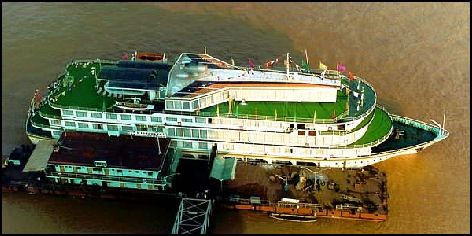
Yangtze river boat
Interesting Sights in the Three Gorges include Goddess Peak in Wu Gorge, reportedly named after a young girl who brings good luck to all those who pass by it; Men-ling's Ladder, where a Shu army surprised an enemy by making holes into the face of a towering cliff and ascending the cliff on a ladder; small terraced farms high along narrow ridges; ancient paths carved into sheer rock cliffs for teams of trackers; and waterfalls gushing out of crevasses in green mountains.
Almost every mountain, side gorge and cliff has a name like the Fairy Princess Rock, the Ox-Liver and Horse-Lung Gorge, Pearl Number One and Two, the Seated Woman or the Punching Lions. There is graffiti on many rocks.
Shibaozhai Stone Treasured Fortress is a 12-story wooden pagoda dubbed as the Pearl of the Yangtze. An embankment was built to protect it when the water levels rose. Baidicheng, at the entrance of Qutang Gorge, is a temple that marks where the poet Li Bai composed a famous poem It has been placed on an artificial island.
Three Gorges Boat Trips are how most tourist visit the Three River Gorges area. Some of the boats are in good condition and tourist have had a wonderful time. Others have broken plumbing, sagging beds, shabby cabins, poor maintenance and rats, and tourists have an awful time. If you are worried about getting stuck on bad boat you are advised to make your travel arrangements with a reputable tour operator like Victoria Cruises (☎ 800-348-8084),Viking River Cruises (877-668-4546); and Uniworld Grand River Cruises (800-733-7820). .
Most of the downstream cruises begin in Chongqing. Passengers usually disembark at Yichang or Wushan, but some continue downriver 1,500 miles to Shanghai. The high season months are April, May, September and October. The shoulder season months are March, June, July, August and November. During the winter, the views are often veiled by mists. The rates for trip with reputable tour company run between $100 and $150 a day.
The Three Gorges has been diminished by the dam but not affected too much. Boats that ran along the river expect to continue working on the lake. Mountains that towered 2,600 to 3,600 feet above the water will be 2,100 feet to 3,100 feet above the water instead. The cliffs are still impressive in many places but the once raging currents have been tamed and the water is now calm. Dizzing footpaths that had ben carved into the cliffs have been submerged.
Yellow River Boat Tours can be organized from Sanmenxia dam to Ruicheng. Along this 40-mile route you will see the Mausoleum for the Yellow Emperor, the Burial Ground for Carriages and Horses, the No. 1 dam on the Yellow River, the Pagoda of Baolun Temple, Shaanxian cave dwellings and hot springs. The water is calm around Sanmenxia but rough around Luoyang. Web Sites: google “river trips in China,” “Yangtze River Cruise,” “Three Gorges” and “Yellow River Tours” and many tour companies come up.
Skiing
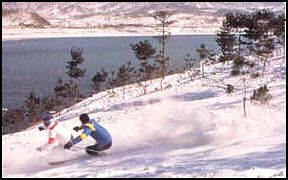
Skiing in Jilin
A cliff painting discovered in Xinjiang in the early 2000s suggests that Stone Age men in the region skied. In the mid 1990s there were no ski resorts and only 500 skiers in all of China and most of them were professional athletes. By 2005, about 5 million Chinese hit the slopes at 200 ski resorts.
Most of the resorts have less than 10 runs and a vertical drop of less than 500 meters. Most of the ski resorts are in the mountains north of Beijing. The largest resort, Yabuli, is near the Russian border. It hosted the ski events of the 1996 Asian Winter Games. There is an indoor ski slope in Shanghai or least there was.
Skiers at Chinese ski resort near Beijing tend to flock to beginner slopes and avoid the more difficult runs. Much of the snow is artificially made. Between runs skiers drink green tea rather than hot chocolate and snack on broiled pork and egg-filed crepes with scallions and hot sauce. Snowboarding is not very yet but is in the process of catching on.
The season ski usually lasts from mid-December to mid-April. Lift tickets are generally less expensive than the United States. Equipment such as skis, ski boots, cross country skis, snowboards, skates and toboggans can be rented at reasonable rates. Most of the resorts have hotels which are sometimes full during the winter. Make sure to make reservations well in advance of your arrival date.
There are six ski areas within range of Beijing. One of the newest, the Nanshan ski resort, is 90 minutes northeast of Beijing. Located in a mountainous area, it boasts a double chair lift, 10 slopes and Swiss-style chalets. The conditions are often less than ideal. Were it not for the snow-making equipment there usually wouldn’t be much snow. The area is cold enough it just that it is usually dry in the winter. The has been some discussion about offering summer skiing on artificial grass.
Yabuli International Ski Resort (near Jilin and 230 miles northeast of Harbin) is China’s largest ski resort. It features nine Norwegian-built chair lifts, 13 trails (11 over 1 kilometer and one over 5 kilometers) and a vertical drop of more than 700 meters. The ski season often lasts into April. A lift ticket and rental skis and boots cost less than $50 a day. Accommodation ranges between $15 dormitories and $100 A-frame chalets. Visitors can also enjoy bonfires with rice wine and sleigh rides with a man dressed as Santa Claus.
Songhauhau Qingshan and Beidahu are two other ski resorts in Jilin Province. They have vertical drops of 371 meters and 400 meter respectively. Accommodation ranges from $5 bunks and $50 rooms. The resorts can be reached by train from Harbin and Beijing. Chanbaishan is another ski area in Jilin.
The casino magnate Stanely Ho is considering building a $500 million ski resort near Changchun and Jilin. Changchun will host the 2007 Asian Winter Games. The China Ski Corp. sponsors two week, ski, walking and driving tours in Heilongjiang and Qinghai Province for around $3,000 including a car and driver. The highlight of the trip is a hike to 5,100 meters on 6,670-meter-high Mt. Animaqin and skiing down on expert slopes.
Web sites: Skiing Association of China; Skiing Web site: skicentral com; Cross Country Skiing Web site: Trailsource.com Web Sites: GoChina About.com About.com ; Beijing Ski Club Beijing Ski ; Yatour Yatour
Winter Sports
Some Beijingers take regular wintertime dips in holes broken through the ice in Sichahai Lake north of Beihai Park. The swimmers contend that taking a daily dip in the icy water is good for one's health. In Harbin, swimmers do the same cut holes in the ice in the river. The custom was introduced by Russians. See Places. Chinese also like ro get around on the ice on frozen rivers and lakes in ice chairs and sleds propelled forward with hand-held spikes.
Image Sources: Province maps from the Nolls China Web site. Photographs of places from 1) CNTO (China National Tourist Organization; 2) Nolls China Web site; 3) Perrochon photo site; 4) Beifan.com; 5) tourist and government offices linked with the place shown; 6) Mongabey.com; 7) University of Washington, Purdue University, Ohio State University; 8) UNESCO; 9) Wikipedia; 10) Julie Chao photo site; 11) autef.com; 12) WWF
Text Sources: New York Times, Washington Post, Los Angeles Times, Times of London, National Geographic, The New Yorker, Time, Newsweek, Reuters, AP, Lonely Planet Guides, Compton’s Encyclopedia and various books and other publications.
